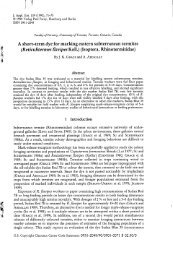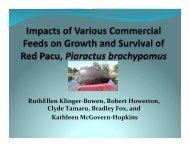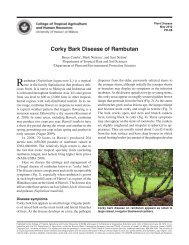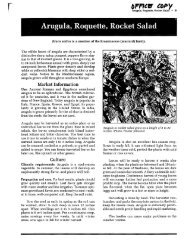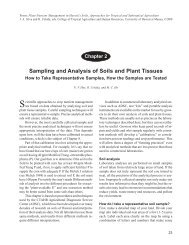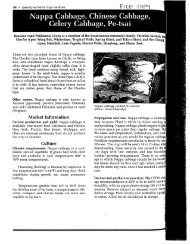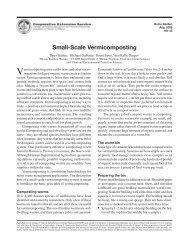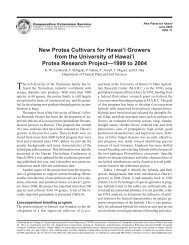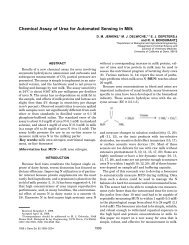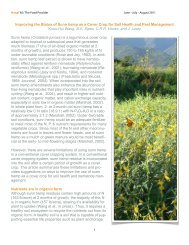Macadamia Nuts in Hawaii: History and Production - ctahr ...
Macadamia Nuts in Hawaii: History and Production - ctahr ...
Macadamia Nuts in Hawaii: History and Production - ctahr ...
You also want an ePaper? Increase the reach of your titles
YUMPU automatically turns print PDFs into web optimized ePapers that Google loves.
Root prun<strong>in</strong>g. The trees propagated <strong>in</strong> the nursery<br />
rows must be root-pruned two to three months<br />
before field transplant<strong>in</strong>g. Root prun<strong>in</strong>g is a technique<br />
whereby the seedl<strong>in</strong>g roots are severed by<br />
stamp<strong>in</strong>g a long, narrow, sharp trench shovel<br />
angled a t about 60° <strong>in</strong>to the root area 6 to 8 <strong>in</strong>ches<br />
(IS to 20 centimeters) from the base <strong>and</strong> about 12<br />
<strong>in</strong>ches (30 centimeters) deep completely around<br />
the grafted trees. The pruned roots with<strong>in</strong> the<br />
<strong>in</strong>verted soil cone thus created will then develop a<br />
new conf<strong>in</strong>ed system of feeder roots, <strong>and</strong> will reduce<br />
transplant<strong>in</strong>g shock <strong>and</strong> losses. To further<br />
encourage proper root development, it is advisable<br />
to cut some weaker root laterals at the time the<br />
trees are lifted for field transplant to permit only<br />
two or three strong laterals to develop.<br />
Graft<strong>in</strong>g of <strong>in</strong>-field planted seedl<strong>in</strong>gs. Citrus<br />
<strong>and</strong> some other temperate-zone tree crops propagated<br />
<strong>in</strong> conta<strong>in</strong>ers or nursery rows produce root<br />
systems that take to the field <strong>and</strong> develop structural<br />
root systems <strong>in</strong> the field thatare apparently strong,<br />
healthy, <strong>and</strong> able to withst<strong>and</strong> w<strong>in</strong>dthrow. However,<br />
macadamia trees similarly propagated respond<br />
somewhat differently after field plant<strong>in</strong>g.<br />
The reason for this difference is that macadamia<br />
laterals <strong>and</strong> taproots extend well beyond the seedl<strong>in</strong>g<br />
trees <strong>in</strong> the nursery rows, <strong>and</strong> these necessarily<br />
are severed <strong>in</strong> root prun<strong>in</strong>g to conf<strong>in</strong>e the root<br />
system to a manageable size for field transplant<strong>in</strong>g.<br />
In conta<strong>in</strong>er-propagated trees the same problem<br />
exists s<strong>in</strong>ce the structural laterals, as well as the<br />
taproot system, grow out <strong>and</strong> beyond the conta<strong>in</strong>ers<br />
<strong>and</strong> aga<strong>in</strong> need to be severed before field<br />
plant<strong>in</strong>g. In either method, the root system of<br />
grafted trees of macadamia for field transplant is<br />
greatly reduced; these trees do not redevelop as<br />
well <strong>in</strong> the field, or are delayed. As a direct result of<br />
this delay or underdevelopment, the young trees<br />
<strong>in</strong> the field are highly susceptible to w<strong>in</strong>dthrow<br />
even <strong>in</strong> a mild w<strong>in</strong>d. Some trees are so weak at<br />
transplant<strong>in</strong>g that they beg<strong>in</strong> to lean dur<strong>in</strong>g the<br />
first year <strong>in</strong> the ground <strong>and</strong> need to be staked. This<br />
vulnerability after transplant<strong>in</strong>g extends to about<br />
10 years of age <strong>in</strong> the field. However, after this<br />
<strong>in</strong>itial period, the tendency to w<strong>in</strong>dthrow is very<br />
much reduced.<br />
To lessen this disproportionate redevelopment<br />
of roots <strong>in</strong> the field after the roots are necessarily<br />
severed <strong>in</strong> the nursery, perhaps small, conta<strong>in</strong>erpropagated<br />
nursery seedl<strong>in</strong>gs (Fig. 53) with unsevered<br />
roots should be planted <strong>in</strong> the field before<br />
graft<strong>in</strong>g. In this manner the roots will be permitted<br />
to extend <strong>and</strong> develop <strong>in</strong> the field as strong laterals<br />
<strong>and</strong> a taproot that need not be severed. The roots<br />
may then be more than 10 feet long before graft<strong>in</strong>g,<br />
<strong>and</strong> very strong.<br />
In a test of this method carried out a t Keaau<br />
Orchard <strong>in</strong> the 1950s, the trees stood up very ,,,,ell<br />
<strong>in</strong> w<strong>in</strong>dstorms, with only broken limbs <strong>and</strong> no<br />
w<strong>in</strong>dthrow. Perhaps larger trials of this method<br />
are <strong>in</strong> order. Obviously, pregraft<strong>in</strong>g field ma<strong>in</strong>tenance<br />
<strong>and</strong> graft<strong>in</strong>g-<strong>in</strong>-the-field costs will be<br />
higher, but the compensation <strong>in</strong> sturdier trees<br />
that will not be susceptible to w<strong>in</strong>dthrow may be<br />
worth the effort. Or, perhaps these small seedl<strong>in</strong>gs<br />
should be grafted <strong>in</strong> the mist chamber, much ak<strong>in</strong><br />
to the practice now develop<strong>in</strong>g <strong>in</strong> Australia, <strong>and</strong><br />
planted <strong>in</strong> the field as soon as possible.<br />
Spac<strong>in</strong>g of Plant<strong>in</strong>g<br />
One of the more important considerations <strong>in</strong><br />
profitability of field operations is spac<strong>in</strong>g of<br />
plant<strong>in</strong>g. The <strong>in</strong>itial cost of establish<strong>in</strong>g an<br />
orchard <strong>and</strong> the ma<strong>in</strong>tenance cost until a positive<br />
cash flow develops at about the eighth year is very<br />
high. The first commercial harvest beg<strong>in</strong>s about<br />
the fifth year after the grafted trees are set out <strong>in</strong><br />
the field. S<strong>in</strong>ce there is no <strong>in</strong>come dur<strong>in</strong>g this<br />
early period, a critical decision on develop<strong>in</strong>g this<br />
cash flow as soon as possible is necessary. A good<br />
way to do this is to plant some fast-grow<strong>in</strong>g cash<br />
crops <strong>in</strong> the <strong>in</strong>ter-row areas dur<strong>in</strong>g the first few<br />
years. Corn, sweet potatoes, <strong>and</strong> some other vegetable<br />
crops can be planted profitably. However,<br />
sometimes the care <strong>and</strong> ma<strong>in</strong>tenance of the immediate<br />
crop becomes more important, <strong>and</strong> the macadamias<br />
can be neglected; this may negatively affect<br />
overall profitability. Instead of us<strong>in</strong>g <strong>in</strong>terplanted<br />
crops, the orchardist can use a system of denser<br />
plant<strong>in</strong>g of macadamias with the <strong>in</strong>tention of<br />
elim<strong>in</strong>at<strong>in</strong>g trees as they beg<strong>in</strong> to close <strong>in</strong>. This is<br />
basically a system of <strong>in</strong>tercropp<strong>in</strong>g with macadamias,<br />
<strong>and</strong> there is no doubt that the trees will get<br />
all the culturaI a ttention they deserve.<br />
Most of the commercial orchards <strong>in</strong> <strong>Hawaii</strong><br />
today have been planted <strong>in</strong> a square pattern, 25 feet<br />
(6.4 meters) by 25 feet (6.4 meters), to give 70 trees<br />
per acre. Castle & Cooke planted Keaau Orchard<br />
<strong>in</strong> the 1950s at 70 trees per acre with the <strong>in</strong>tention<br />
of th<strong>in</strong>n<strong>in</strong>g out alternate trees slowly as the permanent<br />
trees extended <strong>in</strong>to the space occupied by<br />
these trees. The f<strong>in</strong>al, permanent orchard would<br />
then have 35 trees per acre with a spac<strong>in</strong>g of 35 feet<br />
between trees on the diagonal. After 30 years, the<br />
43



